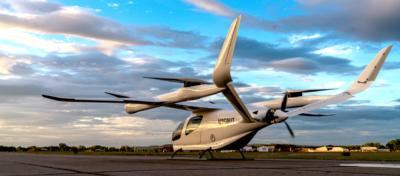On Progress’s Rising Tide
New York’s Blade Air Mobility, Inc.—a purveyor of local and regional, by-the-seat, Advanced Air Mobility (AAM) and jet travel services—and BETA Technologies—a Burlington, Vermont-based manufacturer of electric Vertical Takeoff and Landing (eVTOL) aircraft—announced the recent successful test-flight of BETA’s ALIA-250 EVA (Electric Vertical Aircraft) at the Westchester County Airport (HPN) in White Plains, New York.

The flight marked the first test of a piloted EVA in the greater New York City area and instantiated an initial success of the two companies’ plan to bring safe, quiet, and sustainable air-transportation to commuter and commercial customers.
Blade Mobility CEO Rob Wiesenthal remarked: "This is a historic moment for Blade, New York, and the urban air mobility industry. This demonstration is a big milestone in our transition from helicopters to electric vertical aircraft, and we are pleased that our partners at BETA have designed the right aircraft with the requisite range, capacity, and noise profile for use in our key markets—including our homebase of New York City. We are confident EVAs will be a game-changer both for our company and New York City’s transportation system once certified by the FAA."
BETA founder and CEO Kyle Clark echoed Mr. Wiesenthal’s sentiments, stating: "Blade is flying passengers in key urban markets all over the world, and this flight is another step toward delivering our electric aircraft to support those operations. We continue to progress our aircraft, flying real-life missions and gaining proficiency in the national airspace. We were glad to be able to fly here from our flight test facility in Plattsburgh to work with Blade to operationalize our partnership."
Inspired by the physiology of the Arctic tern, the world’s longest-migrating bird species, BETA’s ALIA-250 eVTOL’s lift scheme comprises rotor-borne vertical lift and wing-borne forward lift. Transition between the two lift architectures is via the engagement of an aft fuselage-mounted pusher propeller and stowage of the aircraft’s fixed, forward and aft rotor pairs. By eschewing articulating (hinged) rotors, BETA engineers reduced the complexity and manufacturing cost of its eVTOL offering.
The ALIA-250 is powered by sealed battery packs mounted beneath the machine’s cabin floor for purpose of enhancing stability and mitigating turbulence. Subject battery packs, in turn, power a distributed direct-drive electric system, the noise profile of which is one-tenth the decibel-level of conventional helicopters. The ALIA-250’s ovular, helicopter-like fuselage and cabin accommodate up to six occupants.

BETA’s rapid charging system offers ALIA-250 operators a charging capacity of 480-volts AC, three-phase at 60-hertz, with an AC grid current of 450-amps and a continuous power rating of 350-kilovolt-amps (kVA). An obscure metric, the kilovolt-amp represents the product of an electrical system’s total voltage and amperage. Kilovolt-amps measure an electrical generator’s apparent power—which is to say the total power generated by a power plant or a generator.
The system further offers a battery charge range of up to 950-volts DC, with a continuous charge current of 350-amps and boost charge current of 500-amps.
So powered, the ALIA-250 manages a range of approximately 250-nautical-miles and a maximum cruise speed of 146-knots.
In April 2021, Blade announced an agreement by which its network of operators will purchase up to twenty, passenger-configured ALIA-250 aircraft to service the company’s routes. To support the proposed operations, BETA will provide and install charging infrastructure at key locations along Blade’s route network.
 Airborne-Flight Training 05.09.24: ERAU at AIAA, LIFT Diamond Buy, Epic A&P
Airborne-Flight Training 05.09.24: ERAU at AIAA, LIFT Diamond Buy, Epic A&P ANN's Daily Aero-Term (05.07.24): Hazardous Weather Information
ANN's Daily Aero-Term (05.07.24): Hazardous Weather Information Aero-News: Quote of the Day (05.07.24)
Aero-News: Quote of the Day (05.07.24) NTSB Final Report: Cessna 150
NTSB Final Report: Cessna 150 Aero-News: Quote of the Day (05.08.24)
Aero-News: Quote of the Day (05.08.24)




